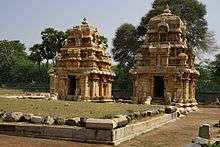Velir
The Velir were a royal house of minor dynastic kings and aristocratic chieftains in Tamilakam in the early historic period of South India.[1] They had close relations with Chera, Chola and Pandya rulers through ruling and coronation rights.
| Velir | |
|---|---|
| Country | India |
| Titles | Satyaputra |
| Connected families | Ay Athiyamān Malayamān Vēl Pāri Irunkōvēl Nannan Vel Avi Pekan |
| Estate(s) | Thamizhagam |
Origin
According to the Tholkappiyam, the earliest work of Tamil literature, eighteen clans of the Velirs came from the city of Tuvarapati under the leadership of the sage Agastya.[1][2][3] The legend goes that all the gods and sages went to the Himalayas to attend the marriage of Siva with Parvati due to which the earth started tilting to one side. Agastya was then requested to proceed south to restore the balance. On his way south, Agastya married Lopamudra and is said to have brought with him sage Jamadagni's son Trnadhumagni or Tholkappiyar, the author of Tamil grammar, and eighteen members of the Vrishni family along with eighteen crore Velir and Aruvalar.[4] It has been suggested by some like Thapar and Champakalakshmi, that the ancestors of the Velir may have been related to the Yadava of Dvaraka and the inhabitants of the post Harappan Chacolithic Black and Red ware sites. According to Thapar, the Yadava may have belonged to a non Indo-Aryan language group.[2] They eventually reached Tamraparni, and as the Velir-Perumakan group, cultivated its ancient civilisation as a political, sociocultural and economic structure in South India and Sri Lanka.[5]
Historians consider the Ay velirs are originally from the cowherd caste of Ayars and they gained preeminence at an early stage in Tamil history.[6][7]
Velir chiefs

Athiyamān Nedumān Añci and his son Ezhini, were Athiyamān chieftains, based in Tagadur (present day village located in Dharmapuri district). They were contemporaries of Auvaiyar. The Sangam poem "Thagadur yathirai", now lost, was written about his battle with the Chera king. Another Velir was Irunkōvēl who ruled over Konaadu, the area in and around Pudukottai, with their capital in Kodumbalur.[8] Nannan was another Velir chieftain who hailed from Tulu Nadu.[9] Yet another Velir chief was Pekan of the Vel Avi family who ruled over Pothini, the modern Palani near Madurai. Other ancient Velir chiefs of repute include Alumbil Vel, Alandur Vel and Nangur Vel.[10]
See also
References
- Mahadevan, Iravatham (2009). "Meluhha and Agastya : Alpha and Omega of the Indus Script" (PDF). Chennai, India. p. 16.
The story of the southern migration of the Vēḷir from Dvārakā under the leadership of Agastya is narrated by Naccinarkkiniyar in his commentary on Tolkāppiyam (pāyiram ; Poruḷ. 34). According to this legend, the gods congregated on Mount Meru as a result of which the earth tilted, lowering Meru and raising the southern quarter. The gods thereupon decided that Agastya was the best person to remedy this situation and requested him to proceed to the South. Agastya agreed and, on his way, visited Tuvarāpati’ (Dvārakā) and led the descendants of neṭu-muṭi-an|n|al (Viṣṇu or Krṣṇa) including eighteen kings, eighteen families of the Vēḷir and the Aruvāḷar' to the south, where they settled down clearing the forests and cultivating the land.
- Pivot politics: changing cultural identities in early state formation processes By M. van Bakel page 165: "The Velir were an instrusive group in South India... It is now suggested that (...) may have been associated with the Yadava of Dvaraka..."
- Romila Thapar. Ancient Indian Social History: Some Interpretations. Orient Blackswan, 1978 - India - 341 pages. p. 224.
- Ramchandra Narayan Dandekar. Insights into Hinduism. Ajanta Publications, 1979. p. 376.
- Thapar, Romila; Champakalakshmi, Radha; Gopal, Sarvepalli (1996). Tradition, Dissent and Ideology: Essays in Honour of Romila Thapar. Oxford University Press. p. 309. ISBN 9780195638677. Retrieved 5 July 2019.
- Marr, John R (1985). "The Eight Anthologies: A Study in Early Tamil Literature". History. Institute of Asian Studies. p. 195.
- Padmaja, T. (2001). Temples of Kr̥ṣṇa in South India: History, Art, and Traditions in Tamilnāḍu. Institute of Asian Studies. pp. 33–34.
- R. Tirumalai. Studies in the History of Ancient Townships in Pudukkottai. Institute of Epigraphy, State Department of Archaeology, Government of Tamil Nadu, 1981 - Local government - 418 pages. p. 1.
- Rohan Peter, Utsav Manihara. Culture of Creativity: Footprints of Indian Civilization, Volume 3 of Panorama of Indian Culture, Rohan Peter, ISBN 8178880253, 9788178880259. Dominant Publishers and Distributors, 2001. p. 10.
- Seneviratne, Sudharshan (1994). "The Twilight of the Perumakan: South Indian Polity Restructured and Incorporated". In van Bakel, Martin; Hagesteijn, Renée; van de Velde, Piet (eds.). Pivot Politics: Changing Cultural Identities in Early State Formation Processes. Amsterdam: Het Spinhuis. p. 172. ISBN 978-90-5589-007-1.